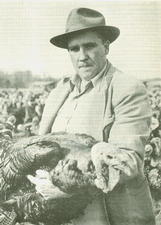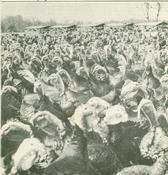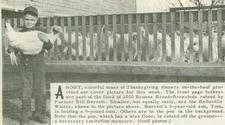Secrets of a Turkey Grower
Secrets of a Turkey Grower
Citizen of the week section by Jim Billings
Bias Magazine, Springfield, Mo., November 21, 1951, pages 16-19
 The car door slammed and 2,000 wrinkled red necks straightened abruptly. From 2,000 throats came a rippling cacophony that is like no other sound in this world. Stocky Bill Barrett, chuckling at this greeting, stepped over the wire fence and was knee-deep in his flock of Bronze Broad-Breasted turkeys. The big birds clustered closely around him. Bill ducked suddenly, swiftly, and came up holding one of the birds by it's feet. He hefted the heap of feathers, stroking the broad, meaty breast.
The car door slammed and 2,000 wrinkled red necks straightened abruptly. From 2,000 throats came a rippling cacophony that is like no other sound in this world. Stocky Bill Barrett, chuckling at this greeting, stepped over the wire fence and was knee-deep in his flock of Bronze Broad-Breasted turkeys. The big birds clustered closely around him. Bill ducked suddenly, swiftly, and came up holding one of the birds by it's feet. He hefted the heap of feathers, stroking the broad, meaty breast.
"He'll go 35 pounds on the hoof, maybe 40," said Bill and there was a certain entirely justifiable pride in his voice.
The next day the tom Bill was holding along with 899 of its brothers was to be sold to a produce dealer who has plants at Carthage and Richland. Bill estimated after some mental arithmetic that he would clear a dollar or more a head on the toms. The toms were 28 weeks old. Bill had started them and the rest of the 2,000 bird flock as poults -newly hatched turkeys to the uninitiated- in April. So from these 900 toms, he stood to make profit of something more than $900 after seven months of anxious care and rather expensive feeding. This gives you a sort of baby's thumbnail sketch of the growing Ozarks turkey business in this pre-Thanksgiving season of 1951.
John William Barrett, who lives on a 120-acre farm a short distance west and north of Springfield's municipal airport, is not yet in the turkey raising business on what turkey raisers would call a large scale. This year he started 3,200 poults-the Broad-Breasted from the Browning Poultry Farms of Winchester, Ky., in April and some Beltsville Whites from the Mound Poultry Farm here in July. He still has 3,000 birds so he's lost only 200 -- a very good mortality rate, he observed.

The turkey raising business in Missouri is growing, Bill said, and he plans to make his share of it grow, too. As of now, he said, Missouri ranks fifth or sixth among the turkey producing states of the nation and Bill believes that the state's reputation for producing eggs with a high fertility rate will boost it even higher in the standings. At present turkeys are, for Bill, just what they are to many another Ozarks farmer -- somewhat of a sideline. He also grows some grain and hay crops on the farms he works, and he has 40 head of cattle, some for beef and a few for milk.
But he wants to change his operations, possibly gradually, more and more to the production of turkeys. "The big trouble in expanding," he said, "is labor. As it is now, I couldn't afford to hire any help. My turkey operation wouldn't justify it. And in order to justify it, I'd have to expand quite a bit."
Bill was born 35 years ago on the farm of his father, John Barrett, on highway 66 at Elwood corner -- just a few miles south of the farm on which he now lives, which is owned by his father-in-law, J. J. Frazier, whose home is close by Bill's. He graduated from Senior High school here in 1934. He went on to the college of agriculture at the University of Missouri, but had to return to the farm after three years because his father was ill and Bill himself had to have a minor operation. His father died in 1940 and Bill now farms his father-in-law's 120 acres as well as his mother's 81 acres. His wife, he said, "is a main cog in the works" of running the farms and more particularly, the turkey-raising projects. They have a five-year-old son, Thomas Anthony.

It wasn't surprising that Bill got into the turkey business since his father's brother, E. L. "Bun" Barrett was sort of a pioneer in turkey raising in this section. "Bun" Barrett quit the turkey business about three years ago and now raises Shetland ponies on his farm near Bill's mother's place and sells real estate. Bill began raising turkeys in 1938 when he started and raised 400. Since then he has been expanding gradually. He always saves a part of his flock as breeders --next spring he'll have 1,400 breeding hens -- and sells the eggs to hatcheries. He buys his poults each year, starts them in clean brooder houses where the temperature is kept at a uniform level by gas or oil-fired brooders. In his big brooder now Bill is using butane gas controlled by a thermostat. He finds it more satisfactory than oil or electricity, he said. If you’re using electricity, he points out and there's a power failure you may wake up some morning and find yourself out of the turkey business. But Bill is reluctant to talk about that darker side of the turkey business. He's had bad years of course like all turkey men but it's hard to get him to go into details.
"You say much about turkeys being susceptible to disease and it gives a lot of people the wrong idea," he said. "As a matter of fact, turkeys that go to the market now can't be diseased. They're inspected carefully." The fact remains, however, that disease can wreak havoc in a turkey flock. Not so much because turkeys are more susceptible than other poultry, Bill believes. "A turkey is a good deal like a sheep." Bill said. "When something hits him, he seems to give up. He doesn't have any resistance, any fight." If there's any one critical stage in a turkey's life, it's when he's about 10 to 11 weeks old, Bill said. That's because turkey men usually shift their birds from the comparative safety of pens to open range at about that time. And it isn't disease so much that bother them then. It's more likely to be weather. In two big pens and a big barn, Bill had about 1,000 Beltsville Whites which, he said should have been on range already. But he was glad he hadn't put them out when the big snow hit a few days ago.
"If I had, a lot of them would be gone now," be said. "The Broad-Breasteds came through all right --didn't lose a one -- but they're bigger and could stand it better. I know a fellow up by Everton who lost about 500 of these Whites in that storm."
The main thing a successful turkey raiser needs, said Bill, is good poults. "Then," he added, "sanitation and more sanitation and still more sanitation. By sanitation, I mean clean feeders, clean waterers, clean pens. And of course, good feed is essential." Raising turkeys now isn't nearly the chore it used to be, even a few years ago, Bill said. "We've learned a lot about better breeding methods, better feeds, and getting more growth on a bird in a shorter period of time," he said. "the new drugs help a lot, too. One of the best is Enepathin, for black head which used to be practically fatal to a turkey."
But there's still a lot of work to the job.
"Gathering, grading and candling eggs from 1,400 hens, and packing them and shipping them to the hatchery is quite a job," Bill said. "And there's been many a season when I've slept with my flock on range every night. Sometimes you've got to do that to keep off marauders -- not only animals but the two legged variety as well. Thanksgiving and Christmas are still the most important marketing seasons to a turkey raiser but the National Turkey Federation of which Bill is a member is carrying on a constant campaign to promote the consumption of turkey the year around. The Whites are an important factor in this campaign.. They're the birds which are raised for frying and broiling-- the "apartment-sized" turkeys you see advertised by stores here.
Bill's Whites will go on the Christmas market. Some of them he'll dress and sell locally. Others will be marketed on the hoof, probably will go to eastern consumers. The market for toms this year is 34 cents a pound, in wholesale quantities, on the hoof. "Be sure and make it plain that that price is strictly for wholesale business and alive, so some of my friends won't be mad when I have to charge them more than that for a dressed turkey," Bill urged. That price is about five cents a pound higher than it was at this time last year --but the price of feed has gone up proportionately so the farmer isn't much, if any, better off this year.
Bill looked out across the glistening backs of his Bronze charges, milling and circling on their range. After tomorrow, he may have been thinking, there'll be 900 fewer to worry about. He grinned and said, "It's sure a relief when you get that Thanksgiving crop on the market.
If you would like more information about raising turkeys and the histories of turkeys and Thanksgiving try these books:
The turkey : an American story by Andrew F. Smith
Giving thanks : Thanksgiving recipes and history from Pilgrims to pumpkin pie by Kathleen Curtain
Storey's guide to raising turkeys by Leonard S. Mercia
Find this article at http://thelibrary.org/blogs/article.cfm?aid=557&lid=30&view=print